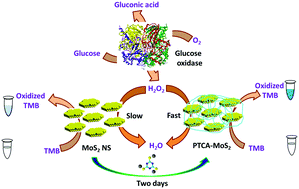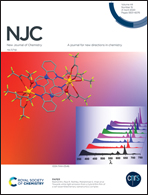In situ polymerization and covalent functionalisation of trithiocyanuric acid by MoS2 nanosheets resulting in a novel nanozyme with enhanced peroxidase activity†
Abstract
A hydrothermal method was used to synthesise 2D MoS2. The resulting nanosheets had a 1T stacking sequence (tetragonal symmetry) as the dominant form, and some 2H stacking (hexagonal symmetry), with an interlayer basal spacing of 6.81 Å. The material was used as a catalyst in the one step polymerisation of trithiocyanuric acid (TTCA) to polythiocyanuric acid (PTCA), resulting in PTCA-functionalisation of the edge sites of the MoS2 to form a continuous, porous, polymeric network. This novel material showed enhanced peroxidase activity relative to native MoS2. Using TMB as a colorimetrically monitored co-substrate, kinetic analysis of the PTCA–MoS2 peroxidase action revealed that the catalyst functioned by a ping-pong mechanism, unlike MoS2 itself where the mechanism was sequential. The PTCA–MoS2 composite exhibited a higher value of Vmax than native MoS2 for an equal quantity of catalyst and could be used for the colorimetric measurement of H2O2 in the range 5 μM to 1000 μM (LOD = 3.8 μM, r2 = 0.992) and the indirect measurement of glucose, using glucose oxidase, in the range 20 μM to 800 μM (LOD = 18.34 μM, r2 = 0.981). The PTCA–MoS2 catalyst was stable for two months when stored at 4 °C.



 Please wait while we load your content...
Please wait while we load your content...